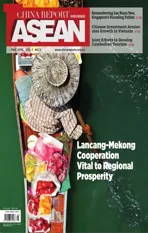Political Trust Key to Transnational Economic Corridor
2016-09-26ByZhangYuan
By Zhang Yuan
Political Trust Key to Transnational Economic Corridor
By Zhang Yuan
A key seminar in accelerating the construction of the Bangladesh-China-India-Myanmar Economic Corridor was held on December 7, 2015 in China’s Yunnan Province, promoting the linking of nations across South and East Asia.
This link across South Asia has grown of increasing importance to China, particularly in Yunnan Province, which submitted a request to accelerate construction of an economic corridor as part of China’s 13th Five-Year-Plan(2016-2020), finalized in March this year. the seminar put forward proposals including taking Yunnan Province as the main jumping othpoint for construction across the corridor and establishing a pilot experimental area.
China and India, the world’s two most populous countries, each have crucial roles to play in the establishment of the corridor, as was stressed by Chinese President Xi Jinping in a meeting with Indian Prime Minister Narendra Modi in September 2014. Xi said that both countries should accelerate construction of the corridor and cooperate within the framework of the Silk Road Economic Belt (the land-based component of China’s Belt and Road Initiative) as well as the 21st Century Maritime Silk Road (the sea-based component). Cooperation should also follow the framework of the Asian Infrastructure Investment Bank (AIIB), Xi added. Modi responded that India intends to study possible participation in the corridor and the AIIB.
This transnational cooperation mechanism among these four countries began as open forum discussions, beginning with various regional conferences and forums that led to the proposed construction of the Bangladesh-China-India-Myanmar Economic Corridor. Bangladesh, China, India and Myanmar have compelling reasons to cooperate. Their economies are each closely linked and the establishment of an economic corridor is expected by economists to boost growth in the region, further giving play to the advantages each country possesses in terms of location, technology, market and culture. Exploiting these advantages looks sure to lead to an enhancement of international competitiveness.
However, the corridor still faces a large number of uncertainties. three key issues are holding the project back.
First, the core issue of what the corridor will entail should be made more clear. What kind of economic cooperation model should be established? In this regard, each of the four countries need to strengthen multilevel communication and coordination. They should discuss short, medium and long-term objectives and establish coordination mechanisms of government departments in cities and regions that find themselves in crucial areas of the corridor. That will lead to more effective solutions to practical problems.
The second issue lies within connectivity itself. the four countries should give priority to transport connectivity, properly allowing the flow of goods through various forms of transportation.
Fortunately, a solution to transportation problems seems close at hand. A section of road between Kalewa to Monywa in Myanmar(less than 200 km) is set to be upgraded to an all-weather passageway, and the road linking Silchar of Assam and Imphal of Manipur in India is also being upgraded.
There are some transportation issues,however, that remain unresolved. For instance,the proposed “northern route” of the economic corridor runs from Yunnan Province to Myitkyina in Myanmar’s Kachin State before extending to Ledo Town in Assam, a state in Northeast India. After passing through the cities of Dibrugarh and Guwahati in northeast Assam, it enters northern Bangladesh, merges into Bangladesh’s central corridor before finally reentering India through the state of West Bengal. this route, however, includes an area in which China and India are involved in a territorial dispute. Armed rebellions are also common in this area, raising security concerns.
To realize these plans of establishing the corridor and convenient transport links,Myanmar is key. the proposed southern, central and northern routes must all go through its territory. The economic corridor cannot avoid armed conflicts in Myanmar no matter which program is adopted. therefore, the success of the corridor is dependent on national reconciliation under Myanmar’s new government. That should be highlighted by each of the four countries involved.
The third issue lies in political trust. Currently, the concerns of countries which lie within the economic corridor mainly lie in uncertainty regarding China’s future security policy orientation or concerns over negative economic impact relating to China’s slowing economic growth. Mutual trust among the four countries remains insufficient. People-topeople exchanges to promote understanding between cultures is of vital importance.
At present, each of the four countries in the corridor needs to focus on exchanges, personnel cooperation and information sharing,deepening mutual understanding and establishing friendlier ties.
Crucially, they need to actively explore the establishment of a long-term mechanism for exchanges and cooperation between governments, think tanks and businesses. Only through proper cultural and economic understanding can the establishment of a crucial regional corridor be established.

About the author:
Zhang Yuan is a researcher of Anbound.
